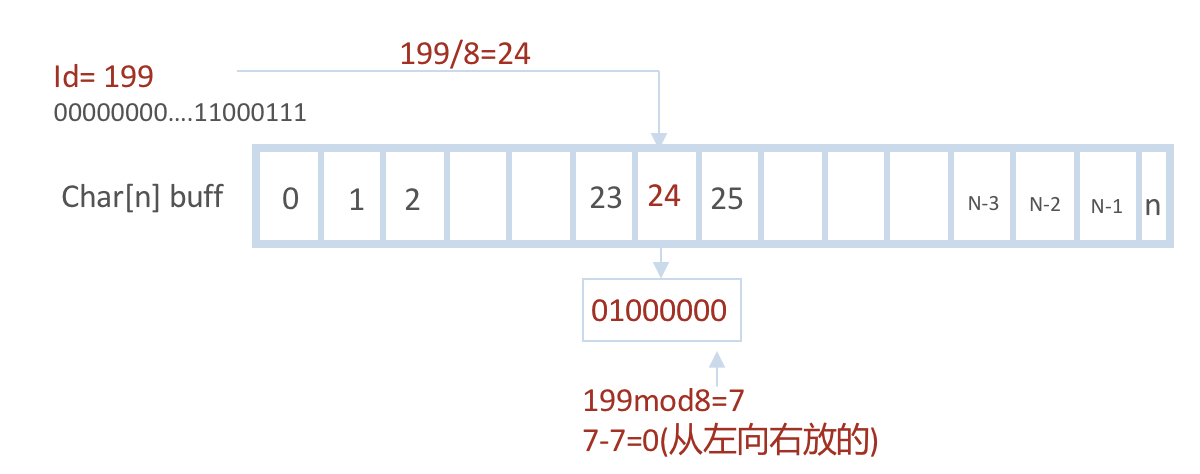redis SETBIT命令原理
/* SETBIT key offset bitvalue */
bitset的使用位来替代传统的整形数字,标识某个数字对应的值是否存在
底层有一个byte[]来实现,byte是程序语言中仅次于位(Bit)的类型,1byte=8bit
在此之上,有short、int、long
1short=2byte=16bit
1int = 4byte = 32bit
1long = 8byte= 64bit
一个数字1转换成2进制bit,如果它一个byte,则为
00000001 从左向右,第1位是符号位,因此byte的大小范围绝对值右后7位决定
基于此原理,我们可以将byte转换成bit形式,如果用0表示不存在,1表示存在,则一个byte就能表示8个事务是否存在
这就是bitmap的基本原理,因为存储8个信息只耗费1byte,那么存储8亿个信息只耗费1亿byte,相比之下,如果使用int来代替,则需要8亿int,也就是32亿byte
他们的相差了32倍的存储空间,如果是long型,则再乘以4,但是为这么多数字分配数组空间的代价实在是太大了,缺少了实用性,因此一般存储个信息个数都只存储int范围。
比较实用的场景如下:
假如有1亿个用户,记录所有用户今天是否登录过,如果登录过bit位值赋1,否则赋0
使用byte[]存储这种状态信息,需要1亿/8 = 1250万byte =12500KB = 12.5MB
场景介绍完后,我们来看看redis中的应用,通过setbitCommand方法来一窥究竟
/* SETBIT key offset bitvalue */
void setbitCommand(client *c) {
robj *o; //redis object,可以简单的理解成key对应的value对象,有对应的数据结构,参见https://www.cnblogs.com/windliu/p/9183024.html尾部
char *err = "bit is not an integer or out of range"; //错误提示字符串
size_t bitoffset; //size_t是标准C库中定义的,应为unsigned int,在64位系统中为 long unsigned int。
ssize_t byte, bit;
int byteval, bitval;
long on;
if (getBitOffsetFromArgument(c,c->argv[2],&bitoffset,0,0) != C_OK) //offset的校验操作,访问内存太大或无效的数字,使用的方式是offset/8,保证他是非负整数,且不超过512MB
//赋值bitoffset = 转换为数字型的offset
return;
if (getLongFromObjectOrReply(c,c->argv[3],&on,err) != C_OK) //校验bit位的value是否在long范围内
return;
/* Bits can only be set or cleared... */ //位只有被set或清除
if (on & ~1) { //算式,如果on 不为0和1,则算式成立,返回错误
addReplyError(c,err);
return;
}
if ((o = lookupStringForBitCommand(c,bitoffset)) == NULL) return;
/* Get current values */
byte = bitoffset >> 3;
byteval = ((uint8_t*)o->ptr)[byte]; //由于byte是primitive(Java的观点),如果没有赋值过,值就是0
bit = 7 - (bitoffset & 0x7); //从左向右方,就像数组下标是从0 -> ...一样
bitval = byteval & (1 << bit);
/* Update byte with new bit value and return original value */
byteval &= ~(1 << bit);
byteval |= ((on & 0x1) << bit);
((uint8_t*)o->ptr)[byte] = byteval;
signalModifiedKey(c->db,c->argv[1]);
notifyKeyspaceEvent(NOTIFY_STRING,"setbit",c->argv[1],c->db->id);
server.dirty++;
addReply(c, bitval ? shared.cone : shared.czero); //返回以前的值
}
1 -> 00000001
~1 -> 11111110
on & ~1 -> 假如on =1 -> 0; on =0 -> 0; on = 3 -> 00000010 = 2
也就是说,不为1和0的byte范围,on & ~1 都是1个大于0的数字,将直接返回错误
同理,当1作为int或long型的时候,依然保留此性质;
下面的代码可以看到bitset具体的存储结构为一个sds字符串
/* This is an helper function for commands implementations that need to write
* bits to a string object. The command creates or pad with zeroes the string
* so that the 'maxbit' bit can be addressed. The object is finally
* returned. Otherwise if the key holds a wrong type NULL is returned and
* an error is sent to the client. */
robj *lookupStringForBitCommand(client *c, size_t maxbit) {
size_t byte = maxbit >> 3;
robj *o = lookupKeyWrite(c->db,c->argv[1]); //找到key对应的对象
if (o == NULL) { //对象不存在,创建
o = createObject(OBJ_STRING,sdsnewlen(NULL, byte+1)); //大小为byte + 1,sds:动态简单字符串,初始化值为NULL,初始化长度 byte + 1,因为max >> 3可能有余数,+1保证maxbit都能存进来,如果初始化值为null,不会占用空间
dbAdd(c->db,c->argv[1],o); //放入db中,redis有16个db,默认使用db0
} else {
if (checkType(c,o,OBJ_STRING)) return NULL; //key对应的不是一个字符串,报错
o = dbUnshareStringValue(c->db,c->argv[1],o);
o->ptr = sdsgrowzero(o->ptr,byte+1);
}
return o;
}
typedef char *sds;
struct sdshdr {
int len; //buf已占用的长度,即当前字符串长度值
int free; //buf空余可用的长度,append时使用
char buf[]; //实际保存字符串数据
}
/* Create a new sds string with the content specified by the 'init' pointer
* and 'initlen'.
* If NULL is used for 'init' the string is initialized with zero bytes.
*
* The string is always null-termined (all the sds strings are, always) so
* even if you create an sds string with:
*
* mystring = sdsnewlen("abc",3);
*
* You can print the string with printf() as there is an implicit \0 at the
* end of the string. However the string is binary safe and can contain
* \0 characters in the middle, as the length is stored in the sds header. */
sds sdsnewlen(const void *init, size_t initlen) {
void *sh;
sds s;
char type = sdsReqType(initlen);
/* Empty strings are usually created in order to append. Use type 8
* since type 5 is not good at this. */
if (type == SDS_TYPE_5 && initlen == 0) type = SDS_TYPE_8;
int hdrlen = sdsHdrSize(type);
unsigned char *fp; /* flags pointer. */
sh = s_malloc(hdrlen+initlen+1);
if (sh == NULL) return NULL;
if (!init)
memset(sh, 0, hdrlen+initlen+1);
s = (char*)sh+hdrlen;
fp = ((unsigned char*)s)-1;
switch(type) {
case SDS_TYPE_5: {
*fp = type | (initlen << SDS_TYPE_BITS);
break;
}
case SDS_TYPE_8: {
SDS_HDR_VAR(8,s);
sh->len = initlen;
sh->alloc = initlen;
*fp = type;
break;
}
case SDS_TYPE_16: {
SDS_HDR_VAR(16,s);
sh->len = initlen;
sh->alloc = initlen;
*fp = type;
break;
}
case SDS_TYPE_32: {
SDS_HDR_VAR(32,s);
sh->len = initlen;
sh->alloc = initlen;
*fp = type;
break;
}
case SDS_TYPE_64: {
SDS_HDR_VAR(64,s);
sh->len = initlen;
sh->alloc = initlen;
*fp = type;
break;
}
}
if (initlen && init)
memcpy(s, init, initlen);
s[initlen] = '\0';
return s;
}
这里需要拓展一下sds字符串,他里面包含了header和char * ,char在c和c++语言中占用一个字节,如果用char来进行位运算,结果和byte来运算是一样
没有使用byte[]的原因
- 程序中,声明一个数组的时候,需要定义长度及类型,此时就会直接分配 类型占用字节数 * 长度len 的内存空间
- 数组的长度一旦确定,就无法动态变化,并且sdk对初始化null之类的操作有很多优化
sds字符串中的char数组可以直接对应byte[]数组
sizeOf、size_t方法大有深意:
CPU一次性能读取数据的二进制位数称为字长,也就是我们通常所说的32位系统(字长4个字节)、64位系统(字长8个字节)的由来。所谓的8字节对齐,就是指变量的起始地址是8的倍数。比如程序运行时(CPU)在读取long型数据的时候,只需要一个总线周期,时间更短,如果不是8字节对齐的则需要两个总线周期才能读完数据。(原文:https://blog.csdn.net/guodongxiaren/article/details/44747719 ),size_t承担了这个工作
字节如果不对齐可能的情况:
0x10000 分别存储了int a(4byte)\short b(2byte)\int c-byte1\int c-byte2
0x10008 分别存储了int c-byte3\int c-byte4...
为了读int c变量,可能需要两次读操作
位置寻找方法图

更新操作
然后修改指定bit位,更新char[] buff对应下标的值,返回原来的值,结束



